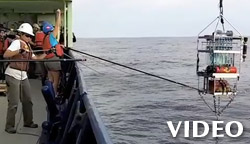

Despite the most thorough preparations, sometimes things do not go as planned. In this video you will see two recoveries of the SID-ISMS instrument, one that went perfectly and one that hit a bit of a snag. SSSG Allison Heater shows what happened.
VIEW VIDEO »

Today's Weather
Sunny
Lat: 35.23 N
Long: 21.47 E
Air temp: 18.4°C, 65.1°F
Bar. Pressure: 1023.0 mbar
Humidity: 65%
Sea surface temp: 20°C, 68°F
Winds: SW; 13.2 knots
Visibility: unlimited

Greek Origin
Word of the Day:
Oxygen
from the Greek words “oxys” meaning acid and “genes” meaning formation; because oxygen was considered essential in the formation of acids
More than one way to collect a microbe
December 5, 2011 (posted December 6, 2011)
by Cherie Winner
The team of scientists handling the water sampler called the Submersible Incubation Device-In Situ Microbial Sampler (SID-ISMS) has had some very long nights on this cruise. After its first deployment, which was very successful (see Daily Update 2), each time SID-ISMS was sent down to a Deep Hypersaline Anoxic Basin it came back with some samples, but also with a new problem. The scientists would stay up most of the night solving that one, only to see a different problem develop during the next deployment.
Chief Scientist Ginny Edgcomb, Craig Taylor, and McLane Research Laboratories, who have been working on the design and construction of SID-ISMS for two years, say most of the problems have been due to the intense pressure at a depth of 3,500 meters—about 350 times as much as we experience on land, or more than 5,000 pounds per square inch. That’s like having an elephant standing with his whole weight on the tip of your thumb.
“Weird things can happen to materials at pressures like that,” says Ginny. Even something as simple as an O-ring, the rubber ring that helps seal valves and chambers, might fail at depth because high pressure could compress it so that it’s not as springy as it needs to be to do its job.
When they get home, Ginny, Craig, and their colleagues at McLane Research Labs will work on making all of the components of SID-ISMS stronger. They are trying so hard to get the instrument to work because once it does, it will be one of the most powerful tools they have for studying microbial life in the deep sea.
That’s because SID-ISMS doesn’t just collect water samples and bring them back to the ship. Oceanographers have had a good way to do that for many years; it’s called a Niskin bottle. If you’re going to measure chemicals in the water, Niskin bottles work great. They’re even probably OK if you want to study the bacteria and archaea that are in the water. But nobody knows how many bacteria and archaea do not survive the journey up from the deep in Niskins.
And if you want to study eukaryotic microbes, they’re not good at all. Eukaryotes are organisms whose cells have a nucleus and other membrane-bound organelles such as mitochondria. Most are much more sensitive to changes in pressure, oxygen levels, and other factors than many bacteria and archaea are.
If your goal is to learn about the microbes that live near the seafloor, you need a way to fix, or preserve, them right at the seafloor so you can see what they looked like and what they were doing in their natural habitat. That’s what SID-ISMS is designed to do—that’s what the “in situ” in its name means.
But over the weekend, the team decided to go to its backup plan. They opened the crate that has been sitting at one end of the main lab since we left port, and brought out Deep SID.
Before SID-ISMS was made, Deep SID (which was also co-designed by Craig Taylor) was the deepest-working in-situ sampler. It can go to 1,000 meters. It works by mixing water samples with a fixative such as formaldehyde, so the protists are preserved as soon as they are collected.
When Ginny and Bill Orsi studied the protists of the Cariaco Basin in Venezuela a few years ago, they found that water brought up in Niskin bottles contained very few intact protists, but Deep SID brought back many, many kinds of protists. In fact, Deep SID’s success on that project was one reason Ginny and Craig set out to build an instrument that could go even deeper and do even more with the samples.
So during the past two days, the team has put Deep-SID together and given it a test run. It did so well that Maria Pachiadaki started an experiment using Deep-SID to study protists that prey on bacteria. We’ll learn more about that experiment in tomorrow’s update.
[ Previous update ] [ Next update ]
[Back
to top]
|
